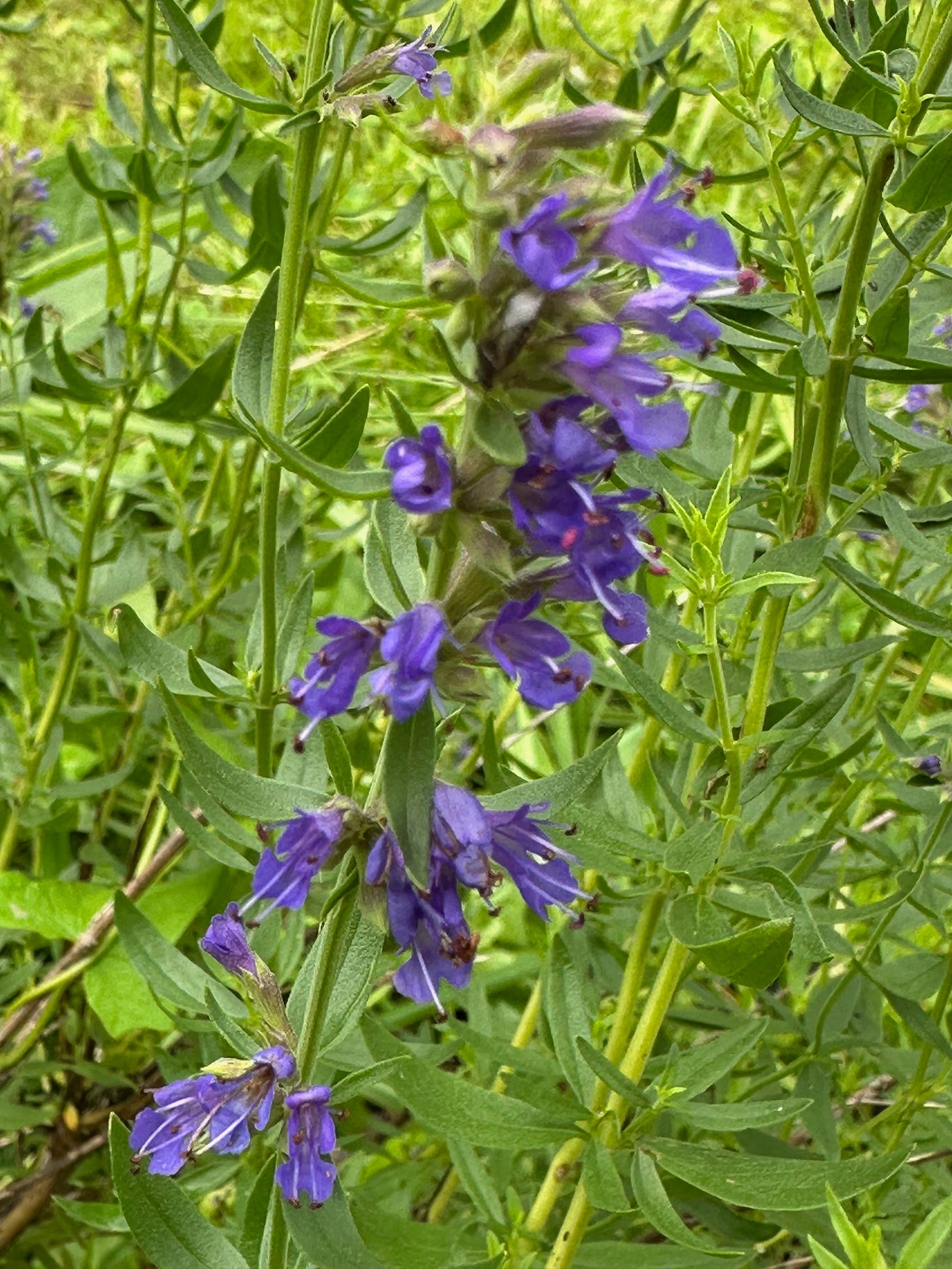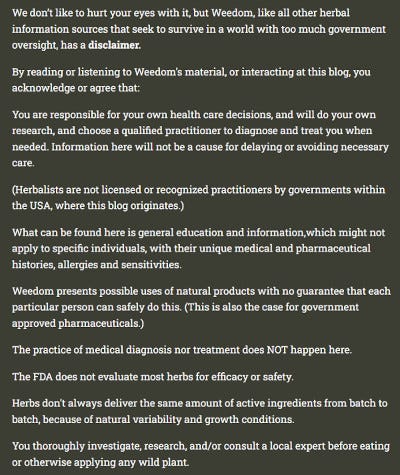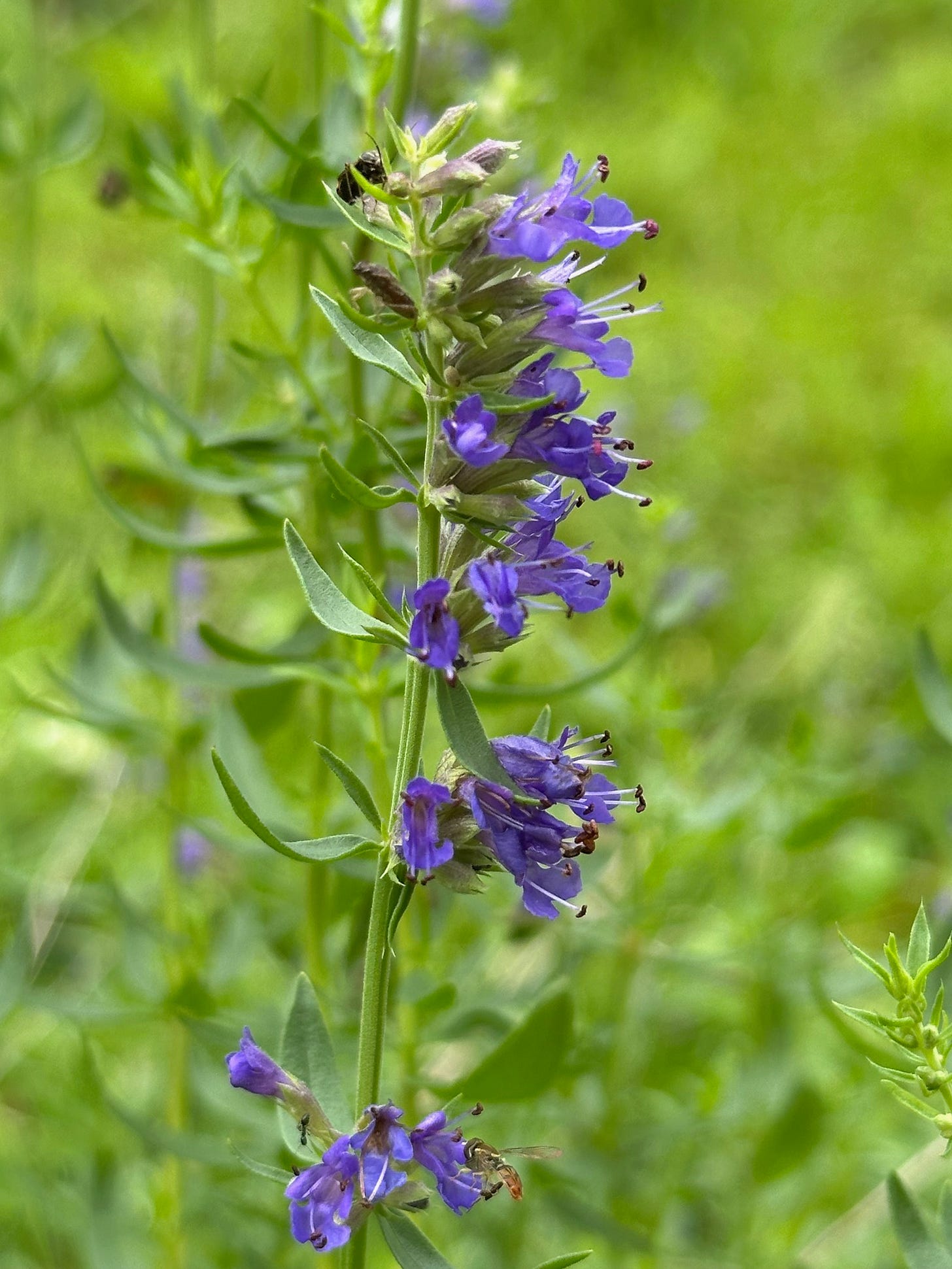The true and traditional Hyssopus officinalis, which hails from the Mediterranean regions, and parts of eastern Europe, may be considered the “real” medicinal hyssop, particularly for Western people. This is the case despite the controversy over which herb was used for ritual cleansing and medicine at various points in the Biblical history timeline. Many of our readers are familiar with the species name “officinalis” or “officinale”, which is often appended to the Linnean or Latin name of a species of plant which had long been used for medicine, and was kept in the “officina” or herb compounding and storage space of a monastery or an apothecary.
This post continues from the previous one:
The long-revered hyssop plant has long been in use as a bitter flavoring and medicine for various conditions since times lost in history. Hardy from USDA zones 4a to 9b, the self fertile herb has naturalized in parts of North America, and much of Europe. Hyssopus officinalis has planted itself in India, where it’s called jupha in Ayurvedic medicine. The purple or blueish flowers are common, but since mankind has been messing with this plant for millenia, and carrying it from place to place, bloom colors now range into the pinks and all the way to white.
Pics from our little hyssop patch at weedom will allow you to know this plant when you see it. Both the leaves and the flowers are distinctly aromatic, so that you would not pull out all of such a plant by accident. Hyssop is perennial with a lifespan of about 7 years.
Size of the hyssop plants varies from 1-2 feet (30-60 cm) in height, and it can spread almost as wide it is tall. In many climates this plant is semi-evergreen, retaining some live green leaves through any mild winters or under snow cover, but much of the upper branches tend to die off after frost in our part of USDA hardiness zone 6. The plants benefit from vigorous pruning. They can be propagated from non flowering stem cuttings in the spring or the fall, by rooting in a sandy mix. Narrow lance shaped leaves are about 1 inch (2.5 cm) long emerging directly and oppositely from the stem at each node, and in alternating directions along the stem in the usual mint fashion. New stems emerge from the leaf axilla, and at the top of a flowering spike, blooms arise in similar fashion. Leaves are often smooth at the margins, but some cultivars might have toothed leaves. Generally the leaf surface is smooth, somewhat shiny, glandular and aromatic. Stems of the plant are square in cross section, and become woody at the base, with the youngest stems remaining green and pliable.

Blooms ranging from blue through purple, pink, and sometimes white are tubular with 2 lips, the upper being somewhat shorter than the wider lower lip. Numerous flowers are arranged in whorls on a spike of about 3 inches or 8 cm. in length. Each bloom is surrounded by a calyx of 6 tepals which is about a half centimeter in length. The self fertile blooms (about 1 centimeter in length) have both male and female parts, with the 4 male anthers protruding outward beyond the edges. Seeds are produced in the single pistil structure, and these will require light for germination. Richo Cech, a knowledgable and successful propagator of medicinal plants , recommends that the seeds be scarified with fine sandpaper to increase germination rate.

Hyssop prefers well drained soil, with pH range from 6.6 to 8.5 in a mostly sunny area of temperate zones. In the sunniest climates it might prefer partial shade in the hottest part of the day. Once the plant has become well rooted, it is quite drought tolerant, surviving our driest years without much extra attention. In the raised plot of our herb garden, it’s also surviving our recent rains.
It is thought that the blue to purple flowered species produce the highest yield of essential oils, which vary a good deal by cultivar and by where they are grown. Two main herbal chemotypes, linalool and pinocamphone, are identified based upon their predominant essential oil constituents. Some of the most common of these are pinocamphone and cis-pinocamphone, α-pinene and β-pinene, sabinene , myrcene , phellandrene , linalool , myrtenol, elemol, and germacrene-D. Many of these constituents are shared by other cleansing and antimicrobial species, such as ground ivy, yarrow, purple dead nettle, and artemisia species with which our readers have become familiar.
Traditionally hyssop has been used for its cleansing, antimicrobial properties (largely attributable to the aromatic essential oils), topically for wound healing, for diuresis, as a diaphoretic, carminative, topically and internally for rheumatism, and to alleviate respiratory infections and coughs, and even as a nervine. Older uses have been for liver and urinary health, addressing Bright’s disease (nephritis). It is regarded as a stimulating, somewhat drying and warming herb. It had ancient application to stimulate menstrual flow, and from this is derived the recommendations for pregnant women to avoid medicinal use.
Apigenin 7-O-β-D-glucuronide is a major flavonoid of hyssop. Hyperoside, rutin, vicenin chrysoeriol, vitexin diosmin and isoquercetrin are also significant flavonoids repeatedly found in this species, as well as aglycones quercetin and luteolin. The most abundant phenolic acids are ferulic acid and caffeic acid.
The diterpene lactone, marrubiin, has been credited for the long noted, expectorant properties of hyssop. Marrubin also seems to have some pain relieving (antinociceptive) activity, and smooth muscle relaxant activity. This molecule as well as various flavonoids might support the traditional use of this herb to alleviate rheumatism.
Hyssop is credited with both antispasmodic and anticonvulsive activities (for petit mal). Conversely it is accorded the potential to cause seizures, due to small amounts of thujone present in the plant. (This is possible with bales of the herb, or incorrect use of the essential oil. )
The hyssop flavors have given it a culinary place as a part of bitters for digestive stimulation and relief, as components for the secretive recipes of chartreuse and absinthe liqueurs. Jim McDonald has sussed out the wormwood, anise, fennel, hyssop, and lemon balm constituents which he says are needed for any good absinthe mixture. Perhaps infusing those 5 herbs into some honey would also be good fun, and produce a great flavor.
Honey made by the bees buzzing the hyssop is said to be amazing, but at weedom we have never had huge enough quantities of that herb to determine this for ourselves. Bee keepers of old are said to have applied hyssop to their hives in order to persuade the bees to stay. From our direct observatoins this herb certainly seems to be popular with numerous types of bees and butterflies.
Numerous weeds are able to address insults to the skins such as itchy rash, bug bites, cuts and scrapes. Hyssop is definitely on that list, with either a strong aqueous infusion or juice of the aerial parts of the plant applied directly for relief and healing. A Hollywood (LA) herbalist, Willie Southall, was very enthusiastic about Biblical references to the uses of hyssop and he ran with it. Per John Heinerman Heinerman’s Encyclopedia of Juices Teas and Tonics Mr. Southall advocated the succus or juice of the plant as rapid itch relief, and he produced and sold numerous, hyssop containing topical products. It should be mentioned that both anti-bacterial and anti fungal activity of hyssop extracts have been demonstrated in vitro on a number of Candida species as well as numerous gram negative and gram positive bacterial strains. That and the presence of numerous anti-inflammatory substances within hyssop serve to support his remedies. Mr. Southhall is likely over 90 years of age if he is still among us, but it appears that his once successful business may no longer be active. However he has left a book for us, last published in 2001, that remains available in 2025. In addition, Matthew Wood has memorialized him in The Earthwise Herbal, vol. 1.
(As an aside, I recommend that all people track the treasures that are fading from the internet, and support such preservation efforts as the Internet Archive which stores much of the diverse world of herbalism from when it was curated by humans rather than AI or algorithms. )
For internal use, 2 to 3 grams daily of powdered, hyssop powdered leaves and blooms regarded as a generally safe dose. This amount should be divided into at least 3 administrations. Many people would want to sweeten the infusions of hyssop due to the bitter and spicy flavors. Tea can be made using 2 teaspoons of dried herb steeped in a cup of boiling water for about 10-15 minutes.
A tincture of the dried herb can be made in 1:5 ratio in 45% alcohol can be taken in 1-4 ml quantities, three times a day.
The crushed leaves and flowers, or their juice is best for topical use over a limited area, but a strong infusion will also serve to relieve various skin irritations, as well as wounds and bruises. Hyssop can serve in the place of arnica for pain relief, and for wider applications, (as arnica is for topical use only, and not on open skin).
Producing a syrup using honey and an aqueous extract of hyssop is one way to address congested coughs in winter. Another, for the fans of sweet and sour, is to make an oxymel. Roselee de la Forêt, at LearningHerbs.com, suggests filling up a jar with fresh chopped hyssop, then adding honey a third to half way up the jar, and filling the remainder with apple cider vinegar. Be sure to mix and work out the bubbles, and use a liner if you have a metal lid. This can be left to macerate for 2-4 weeks, then strained to remove the herb. The resulting honey and vinegar infusion can be kept on the shelf or in the refrigerator for half a year or so. Dried herb (a half jar-ful) can also be used for this type of mild preparation, spoonfuls of which can be taken at frequent intervals, with the sweetness being the dose limiting factor :-D.
What are you doing or planning with your hyssop? Inquiring minds want to know. Please share!
1 more cool hyssop pic is way down at the bottom.
Where We Dig
1. Cech R. Growing Plant Medicine. Vol 2. Herbal Reeds, LLC; 2024.
2. Dekker S. How to Plant and Grow Hyssop | Gardener’s Path. Gardener’s Path. March 26, 2025. Accessed July 7, 2025. https://gardenerspath.com/plants/herbs/grow-hyssop/
3. Editorial. Hyssop properties. Botanical online. January 19, 2019. Accessed July 7, 2025. https://www.botanical-online.com/en/medicinal-plants/hyssop-properties
4. Grieve M. Modern Herbal. Echo Point Books & Media, LLC.; 2015. https://openlibrary.org/books/OL36722889M/Modern_Herbal
5. Popoola OK, Elbagory AM, Ameer F, Hussein AA. Marrubiin. Molecules. 2013;18(8):9049-9060. doi:10.3390/molecules18089049
6. Sharifi-Rad J, Quispe C, Kumar M, et al. Hyssopus Essential Oil: An Update of Its Phytochemistry, Biological Activities, and Safety Profile. Oxid Med Cell Longev. 2022;2022:8442734. doi:10.1155/2022/8442734
7. Wood M. The Earthwise Herbal - A Complete Guide to Old World Medicinal Plants. North Atlantic Books; 2008. https://openlibrary.org/books/OL12031143M/The_Earthwise_Herbal
8. Hyssop Monograph. HerbRally. Accessed July 7, 2025. https://www.herbrally.com/monographs/hyssop
9. Hyssop Uses and Plant Profile. Accessed July 7, 2025. https://www.learningherbs.com/blog/hyssop-uses
10. Hyssop. | Henriette’s Herbal Homepage. Accessed July 7, 2025. https://www.henriettes-herb.com/eclectic/hool/hyssop.html
11. Hyssopus officinalis (Hyssop) | North Carolina Extension Gardener Plant Toolbox. Accessed July 7, 2025. https://plants.ces.ncsu.edu/plants/hyssopus-officinalis/
😎








Hyssop is hardy to zone 3, it just isn't evergreen here. But mine died when I cut it all the way back to try to get rid of dead growth.